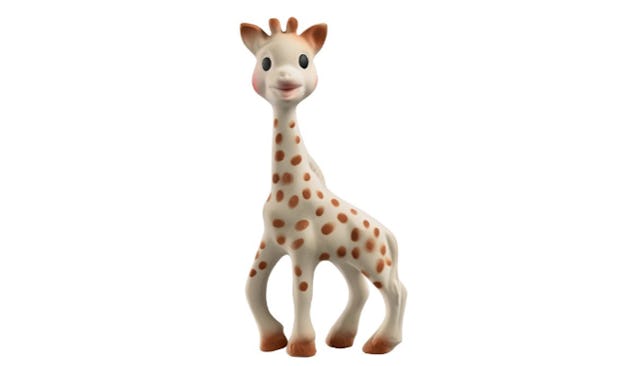If You Don’t Want Toys Filled With Mold, Clean Them

Parents surprised at mold growth inside Sophie the Giraffe toy
Hi, parents. Welcome to Babies 101. First lesson? Babies drool. A lot. And they like to suck on toys. A lot. Moisture in an enclosed space can cause mold to grow, which should be common sense.
Apparently, it’s not.
In the latest edition of Parent’s Freaking Out, we have moms and dads upset that their child’s Sophie the Giraffe teething toy is full of mold. Dana Chianese, a pediatric dentist and mother of two toddler sons, tells Good Housekeeping of her horrifying discovery after noticing a musty smell coming from the hole of her child’s Sophie toy. “I decided to cut into Sophie out of curiosity and discovered a science experiment living inside,” she explains. “Smelly, ugly mold living in my infant’s favorite chew toy!”
Though Chianese followed the cleaning instructions that came with the toy, wiping it down with hot, soapy water and never submerging it, the mold still grew. Understandably, the mom is shaken, saying, “It still hurts my heart to know that for months I allowed my babies to chew on moldy toys. I no longer buy any chew toys with a hole or recommend any to my patients.”
OK, ew. Like, all the ew. We won’t deny that this would be a jarring discovery for any parent, and in the haze of our exhausting lives raising small people who hardly let us sleep, we might forget tiny details. Like the fact that mold growing inside a toy a baby constantly sucks on shouldn’t be a huge surprise.
Yet, Amazon has more than one review, including cautionary photos of gross Sophie toys full of blackish-colored mold, with stories just like Chianese’s. User Stephanie Oprea writes, “Beware!! If you have a drooly baby, moisture will get in the hole and you’ll end up with mold! We’ve had ours for two years and the entire inside is coated with black mold!”
Behold, the grossness.
Image via Stephanie Oprea/Amazon
Another reviewer writes, “My 8-month-old grandson had this giraffe. When it started giving off a foul odor, my son cut it open to find the inside covered with mold. It was not used as a bath toy, but was washed in order to clean it.”
Image via lovestoteach/Amazon
Alright, we get it. It’s shocking and disgusting, but again, shouldn’t come as a huge surprise. And mold is more than just yucky to look at, the CDC says it can cause health issues including respiratory symptoms, itchy eyes and even skin reactions. Luckily, it doesn’t have to be this way, since there are easy ways to keep plastic toys with holes in them clean.
Cleaning website The Maids has several suggestions for keeping bath toys and teething toys clean and free of mold. The most practical and baby-safe among them are:
Vinegar
Mix together 1 gallon of water with ½ cup of white vinegar and let the toys soak in this solution for about an hour. Give them a scrub once the mold is loose and then let them dry. If they still smell like vinegar, just do a simple rise and dry before placing them back in the toy bin.
The Dishwasher
Running bath toys through the dishwasher also sanitizes and kills any gunk or mold that may be growing on both the inside and out. It seems like an overly simple method, but it gets the job done.
Boiling Water
Take the toys and boil them in hot water and squeeze out any of the “yuck” from the insides with some tongs. Let them cool and dry thoroughly.
So, it’s not Sophie’s fault she gets moldy. She just needs a proper cleaning, like any other plastic or rubber toy with a hole in it that your baby regularly gums on.
This article was originally published on